Wikipedia:Picture of the day/June 2006
|
Featured picture tools: |
These featured pictures, as scheduled below, appeared as the picture of the day (POTD) on the English Wikipedia's Main Page in June 2006.
You can add an automatically updating POTD template to your user page using {{Pic of the day}} (version with blurb) or {{POTD}} (version without blurb). For instructions on how to make custom POTD layouts, see Wikipedia:Picture of the day.
June 1 - Thu
[edit]
|
Apartheid, which means "apartness" or "separateness" in Afrikaans, was a system of racial segregation that operated in South Africa from 1948 to the early 1990s. Under apartheid, the races, classified by law into White, Black, Indian, and Coloured groups, were separated, each with their own homelands and institutions. This sign, from 1989, is an example of petty apartheid, which was usually held to mean those measures short of directly affecting employment, residence or voting rights. Photo credit: John Mullen |
Text version ( view - edit - talk - history ) — Condensed version ( view - edit )
Column version ( view - edit ) — Row version ( view - edit )
June 2 - Fri
[edit]
|
Monument Valley is located on the southern border of Utah with northern Arizona in the United States. The valley is recognized worldwide, having been featured in such films as The Searchers and 2001: A Space Odyssey, and its iconic buttes (seen here) have served as the backdrop for Marlboro cigarette ads since the 1950s. Photo credit: Huebi |
Text version ( view - edit - talk - history ) — Condensed version ( view - edit )
Column version ( view - edit ) — Row version ( view - edit )
June 3 - Sat
[edit]
|
Shipka Pass is a scenic mountain pass through Stara Planina in Bulgaria. It is crossed by a road, which runs from Ruse on the Danube River to Stara Zagora and then on to Edirne in Turkey. The maximum altitude of the pass is 1,150 m (3,820 ft). During the Russo-Turkish War, 1877-1878, Shipka Pass was the scene of a series of conflicts collectively named the Battle of Shipka Pass. Photo credit: Psy guy |
Text version ( view - edit - talk - history ) — Condensed version ( view - edit )
Column version ( view - edit ) — Row version ( view - edit )
June 4 - Sun
[edit]
|
|
The Tower Bridge is a bascule bridge that crosses the River Thames in London, England. It was completed in 1894 and the original hydraulic machinery still opens the bridge, although it has been modernised. The central span of 200 feet (61 m) between the towers is split into two equal bascules or leaves, which can be raised to an angle of 83 degrees to allow river traffic to pass. The high-level walkways between the towers houses an exhibition on the bridge's history. Photo credit: Diliff |
Text version ( view - edit - talk - history ) — Condensed version ( view - edit )
Column version ( view - edit ) — Row version ( view - edit )
June 5 - Mon
[edit]
|
Radiolarians are amoeboid protozoa that produce intricate mineral skeletons. They are found as plankton throughout the ocean, and their shells are important fossils found from the Cambrian onwards. This plate by Ernst Haeckel was one of many he drew of radiolarians, helping to popularize these protists among Victorian parlor microscopists. Image credit: Ernst Haeckel |
Text version ( view - edit - talk - history ) — Condensed version ( view - edit )
Column version ( view - edit ) — Row version ( view - edit )
June 6 - Tue
[edit]
|
The term mushroom is usually meant to mean the fruiting body of any fungus, with the mycelium usually being hidden under bark, ground, rotted wood, leaves, etc. A "typical" mushroom consists of a cap supported on a stem. The underside of the cap (in agarics) is fitted with gills where the actual spores are produced. Edible mushrooms are used extensively in cooking. Many varieties are high in fiber and protein, and provide a wide assortment of vitamins and minerals. Photo credit: Eraticus |
Text version ( view - edit - talk - history ) — Condensed version ( view - edit )
Column version ( view - edit ) — Row version ( view - edit )
June 7 - Wed
[edit]
|
Nevado Alpamayo, in the Peruvian Andes, is a steep (sixty degrees), almost perfect pyramid of ice, one of a number of peaks that compose the Santa Cruz massif, the northernmost massif of the Cordillera Blanca. Shown here are three climbers making their ascent (the specks in the area below and to the right of center). It is considered a hard climb, demanding good crampon and axe technique. Photo credit: Brad Mering |
Text version ( view - edit - talk - history ) — Condensed version ( view - edit )
Column version ( view - edit ) — Row version ( view - edit )
June 8 - Thu
[edit]
|
The Amundsen–Scott South Pole Station lies within 100 meters (110 yards) of the Geographic South Pole, making it the southernmost continually inhabited place on the planet. Red lights are used outside during the winter darkness as their spectrum does not pollute the sky, allowing scientists to conduct astrophysical studies without artificial light interference. The green light in the sky is the aurora australis. Photo credit: Chris Danals, National Science Foundation |
Text version ( view - edit - talk - history ) — Condensed version ( view - edit )
Column version ( view - edit ) — Row version ( view - edit )
June 9 - Fri
[edit]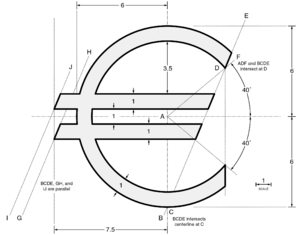
|
The euro is the official currency of the European Union. It is the single currency in the eurozone as well as in some non-member states. All euro coins have a common side showing the denomination and a national side specific to the issuing country. All coins can be used in all member states where the euro is in use. The euro sign is inspired by the Greek letter epsilon and refers to the first letter of the word Europe. The two parallel lines symbolize the stability of the euro. Image credit: Agateller |
Text version ( view - edit - talk - history ) — Condensed version ( view - edit )
Column version ( view - edit ) — Row version ( view - edit )
June 10 - Sat
[edit]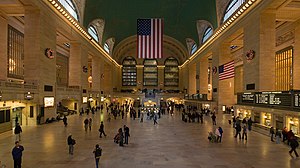
|
Grand Central Terminal (often still called Grand Central Station) is a train station in Midtown Manhattan in New York City. It is the largest train station in the world by number of platforms: 44, with 67 tracks along them. The four-faced clock on top of the information booth in the center of the Main Concourse (shown here) is perhaps the station's most recognizable icon. Photo credit: Diliff |
Text version ( view - edit - talk - history ) — Condensed version ( view - edit )
Column version ( view - edit ) — Row version ( view - edit )
June 11 - Sun
[edit]
|
| Hanko is a small port city on the south coast of Finland, 130 km west of Helsinki. The city has a coastline of approximately 130 km (80 miles), of which 30 km (19 miles) are sandy beaches. There are also over 90 small islands and islets within the city limits. The skyline of Hanko is dominated by the church and the water tower (from which this photo was taken). Both of them received their current appearance after World War II, as their predecessors were either damaged or destroyed by the Soviet Army.
Photo credit: J-E Nyström |
Text version ( view - edit - talk - history ) — Condensed version ( view - edit )
Column version ( view - edit ) — Row version ( view - edit )
June 12 - Mon
[edit]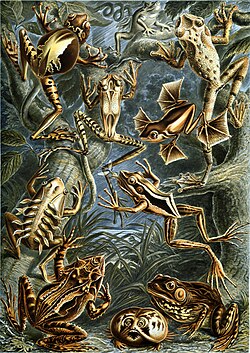
|
A frog is an amphibian characterized by long hind legs, a short body, webbed digits, protruding eyes and the absence of a tail. Frogs are most noticeable through their call, which can be widely heard during the mating season. It is estimated that up to 20% of amphibian species may care for their young in one way or another, and there is a great diversity of parental behaviours. For example, frogs in the Gastrotheca genus (upper left) carry their eggs in a pouch, and females of the Eleutherodactylus lineatus species (center left) carry their young on their back. Illustration credit: Ernst Haeckel |
Text version ( view - edit - talk - history ) — Condensed version ( view - edit )
Column version ( view - edit ) — Row version ( view - edit )
June 13 - Tue
[edit]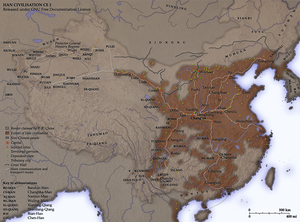
|
The Han Dynasty (206 BCE–220 CE) is considered one of the greatest periods in the entire history of China. During this time, China officially became a Confucian state and prospered domestically. Meanwhile, the empire extended its political and cultural influence over its neighbors before it finally collapsed under a combination of domestic and external pressures. The ethnic majority of Chinese people are known today as Han Chinese, named after this dynasty. Map credit: Yeu Ninje |
Text version ( view - edit - talk - history ) — Condensed version ( view - edit )
Column version ( view - edit ) — Row version ( view - edit )
June 14 - Wed
[edit]
|
Suburbs are inhabited districts located either on the outer rim of a city or outside the official limits of a city, or the outer elements of a conurbation. Although suburbs are stereotyped as having McMansions and a predominantly white and middle- or upper-class population, this image only applies to some suburbs in the United States and Canada. Photo credit: Ian Duke |
Text version ( view - edit - talk - history ) — Condensed version ( view - edit )
Column version ( view - edit ) — Row version ( view - edit )
June 15 - Thu
[edit]
|
|
The Reading Room of the British Museum is situated in the centre of the Great Court. It used to be the main reading room of the British Library, but that relocated to the new British Library building at St Pancras, London. The old Reading Room was opened to the public in 2000, following a renovation by noted architect Sir Norman Foster. It contains a collection of books on history, art, travel, and other subjects relevant to the British Museum's collections, on open shelves. Photo credit: Diliff |
Text version ( view - edit - talk - history ) — Condensed version ( view - edit )
Column version ( view - edit ) — Row version ( view - edit )
June 16 - Fri
[edit]
|
Hay is commonly used as fodder for livestock. It is usually stored in bales that are assembled by balers. The most frequently used type of baler is a round baler, which produces cylindrically shaped 'round' or 'rolled' bales (shown here). Round bales can weigh several tons, and are well-suited for modern large scale farming operations such as a dairy with 200 or more cows. Photo credit: Fir0002 |
Text version ( view - edit - talk - history ) — Condensed version ( view - edit )
Column version ( view - edit ) — Row version ( view - edit )
June 17 - Sat
[edit]
|
Carrots are a root vegetable that can be eaten raw, whole, chopped or shaved into salads for color, and are also often chopped and cooked in soups and stews. β-carotene, a dimer of Vitamin A, is abundant in the carrot and gives this vegetable its characteristic orange colour. Furthermore, carrots are rich in dietary fiber, antioxidants, and minerals. However, as seen here, carrots can be selectively bred to come in many colours. A common urban legend is that carrots aid a human being's night vision. Lack of Vitamin A can, however, cause poor vision and can be restored by adding Vitamin A back into the diet. Photo credit: Stephen Ausmus, USDA |
Text version ( view - edit - talk - history ) — Condensed version ( view - edit )
Column version ( view - edit ) — Row version ( view - edit )
June 18 - Sun
[edit]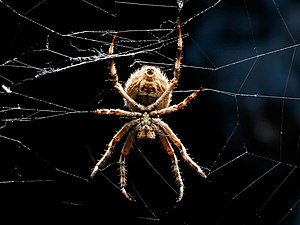
|
The orb-weaver spiders build spiral wheel-shaped webs. In building it, the spider starts with a line, floated on the wind to another surface. The spider secures the line and then drops another line from the center, making a "Y". The rest of the scaffolding follows with many radii of non-sticky silk being constructed before a final spiral of sticky capture silk. Photo credit: Fir0002 |
Text version ( view - edit - talk - history ) — Condensed version ( view - edit )
Column version ( view - edit ) — Row version ( view - edit )
June 19 - Mon
[edit]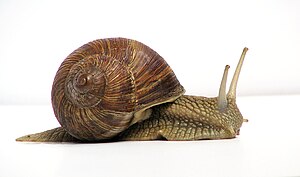
|
The name snail applies to most members of the molluscan class Gastropoda that have coiled shells. Snails are found in freshwater, marine, and terrestrial environments. Snails come in a range of sizes. The largest land snail is the Giant African Snail, which can measure up to 30 cm. The biggest of all snails is Syrinx aruanus, a marine species living in Australia. Photo credit: Jürgen Schoner |
Text version ( view - edit - talk - history ) — Condensed version ( view - edit )
Column version ( view - edit ) — Row version ( view - edit )
June 20 - Tue
[edit]
|
The raspberry (Rubus ideaus) is technically not a berry, but instead an aggregate fruit of numerous drupelets around a central core. It typically grows in forest clearings or fields and is an opportunistic colonizer of disturbed soil (such as by fire or by woodcutting). Xylitol, a sugar alcohol alternative sweetener, can be extracted from raspberries and can prevent or reverse tooth decay. Photo credit: Fir0002 |
Text version ( view - edit - talk - history ) — Condensed version ( view - edit )
Column version ( view - edit ) — Row version ( view - edit )
June 21 - Wed
[edit]
|
Boxing is a sport where two participants of similar weight attack each other with their fists in a series of one to three-minute intervals called "rounds". Modern boxing began in 1867 with the Marquess of Queensberry rules. Currently, there are two distinct branches of boxing: Professional and Olympic, which have different rules, but are similar in execution. Photo credit: Wayne Short/Shawnc |
Text version ( view - edit - talk - history ) — Condensed version ( view - edit )
Column version ( view - edit ) — Row version ( view - edit )
June 22 - Thu
[edit]
|
The light blue soldier crab (Mictyris longicarpus) inhabits beaches in the Indo-Pacific region. Soldier crabs filter sand or mud for microorganisms. They congregate during the low tide, and bury themselves in a corkscrew pattern during high tide, or whenever they are threatened. Photo credit: liquidGhoul |
Text version ( view - edit - talk - history ) — Condensed version ( view - edit )
Column version ( view - edit ) — Row version ( view - edit )
June 23 - Fri
[edit]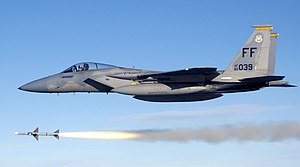
|
The F-15 Eagle is an American-built all-weather tactical fighter designed to gain and maintain air superiority in aerial combat. As of 2005, the F-15 in all air forces has a combined kill record of 104 confirmed kills to zero losses in air combat, although some F-15s have been claimed by surface-to-air missiles. Photo credit: Master Sgt. Michael Ammons, USAF |
Text version ( view - edit - talk - history ) — Condensed version ( view - edit )
Column version ( view - edit ) — Row version ( view - edit )
June 24 - Sat
[edit]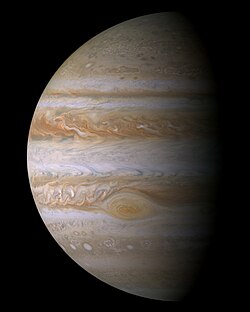
|
Jupiter is the fifth planet from the Sun and by far the largest within the Solar System. It is 318 times more massive than Earth, with a diameter 11 times that of Earth, and with a volume 1300 times that of Earth. Its best known feature is the Great Red Spot, a storm larger than Earth, which was first observed by Galileo four centuries ago. This picture, taken by the Cassini orbiter was one of 26 thousand images taken of Jupiter during the course of its flyby and is the most detailed global color portrait of the planet ever produced. Photo credit: Cassini probe (NASA) |
Text version ( view - edit - talk - history ) — Condensed version ( view - edit )
Column version ( view - edit ) — Row version ( view - edit )
June 25 - Sun
[edit]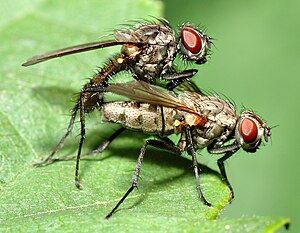
|
"Root-maggot flies" are of the family Anthomyiidae, so named as the species' larvae are typically found in the decaying stems and roots of plants. Some species within the family include the onion fly (Delia antiqua), the wheat bulb fly (D. coarctata), the turnip root fly (D. floralis), the bean seed fly (D. platura) and the cabbage root fly (D. radicum). Photo credit: André Karwath |
Text version ( view - edit - talk - history ) — Condensed version ( view - edit )
Column version ( view - edit ) — Row version ( view - edit )
June 26 - Mon
[edit]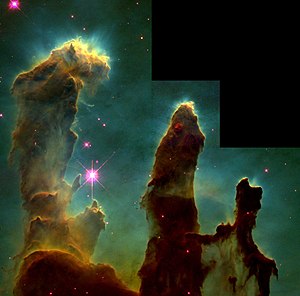
|
Perhaps one of the most famous and easily-recognized space objects, the Eagle Nebula is a young open cluster in the constellation Serpens, about 7,000 light-years away. These interstellar gas pockets of molecular hydrogen act as cosmic incubators for the creation of new stars. Pictured here are columns of gas which have been called the "Pillars of Creation" or "elephant trunks". Within these columns, heavy gas collapses upon itself, and then expands as it absorbs more hydrogen mass from the cocoon-like walls, until a star is finally formed. These columns may reach a light-year in length. Photo credit: Jeff Hester (NASA) and Paul Scowen (Arizona State University) |
Text version ( view - edit - talk - history ) — Condensed version ( view - edit )
Column version ( view - edit ) — Row version ( view - edit )
June 27 - Tue
[edit]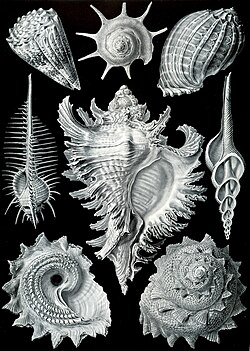
|
Prosobranchia are gastropods with gills in front of the heart. The prosobranchs are almost all marine snails, among them conchs, cones, cowries, limpets, murexes, periwinkles, volutes, and whelks. They all have an operculum, a horny plate situated at the foot, by which the snail can close the aperture, when the body is retracted into the shell. Most have spirally coiled shells. Their nervous system has twisted into a figure-8 shape. The eyes are situated on tentacles. Illustration credit: Ernst Haeckel |
Text version ( view - edit - talk - history ) — Condensed version ( view - edit )
Column version ( view - edit ) — Row version ( view - edit )
June 28 - Wed
[edit]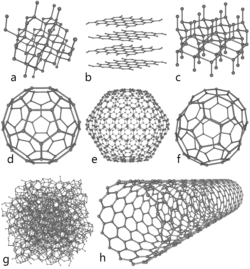
|
Carbon is a chemical element in the periodic table that has the symbol C and atomic number 6. It occurs in all organic life and is the basis of organic chemistry. This nonmetal also has the interesting chemical property of being able to bond with itself and a wide variety of other elements, forming nearly 10 million known compounds. This illustration depicts eight of the allotropes (different molecular configurations) that pure carbon can take (top to bottom, left to right): a) Diamond, b) Graphite, c) Lonsdaleite, d) Buckminsterfullerene (C60), e) C540, f) C70, g) Amorphous carbon, h) single-walled carbon nanotube. Image credit: Michael Ströck |
Text version ( view - edit - talk - history ) — Condensed version ( view - edit )
Column version ( view - edit ) — Row version ( view - edit )
June 29 - Thu
[edit]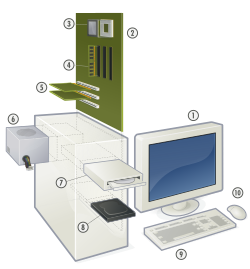
|
The term personal computer was popularized by IBM to mean a microcomputer whose price, size, and capabilities make it suitable for personal usage. In today's common usage, the term usually indicates an IBM PC compatible. A common PC today usually consists of the following components (shown here): Display, motherboard, CPU (microprocessor), primary storage (RAM), expansion cards, power supply, optical disc drive, secondary storage (HD), keyboard, and mouse. Illustration credit: Gustavb |
Text version ( view - edit - talk - history ) — Condensed version ( view - edit )
Column version ( view - edit ) — Row version ( view - edit )
June 30 - Fri
[edit]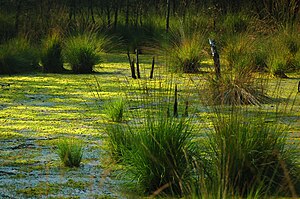
|
A bog is a wetland type that accumulates acidic peat, a deposit of dead plant material. Bogs are widely distributed in cold, temperate climates, mostly in the Northern Hemisphere. Shown here is a bog in Lütt-Witt Moor, Henstedt-Ulzburg, Germany, in late August 2005. Photo credit: Jan van der Crabben |
Text version ( view - edit - talk - history ) — Condensed version ( view - edit )
Column version ( view - edit ) — Row version ( view - edit )
Picture of the day archives and future dates
